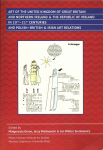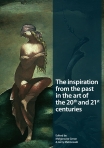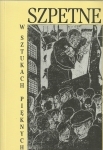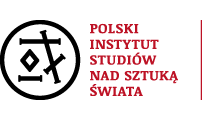TOMY ARCHIWALNE

VOL. 5: MAŁGORZATA GERON, JERZY MALINOWSKI, JAN WIKTOR SIENKIEWICZ (eds.), Art of the United Kingdom of Great Britain and Northern Ireland & Republic of Ireland in 20th–21st centuries and Polish–British & Irish Art Relations
Spis treści / Contents: INTRODUCTIONS: JERZY MALINOWSKI, On the Book; PAUL COLLINSON, England’s Favourite Landscape: Paintings in Search of The Picturesque and Cautionary Tales of Landscape; KRZYSZTOF CIESZKOWSKI, Documentation of Modern British Art: Archives, Libraries and Bibliographies; POLISH –BRITISH ART REL ATIONS BEFORE 1945: DAVID BINGHAM, Albert Lipczinski (1876–1974); PIOTR KOPSZAK, Henri Gaudier-Brzeska’s “Polish” Identity and Contacts with Polish Artists; IZABELA CURYŁŁO-KLAG, Poles in Wyndham Lewis’s Accounts of Early 20th-century Bohemia; DOMINIKA BUCHOWSKA, Whitechapel Boys and the British Avant-Garde: In Search of the Polish Connection; MAGDALENA ZDRENKA-CIAŁKOWSKA, The Art of Advertising in Poland and Great Britain. “Levitt–Him” as a Design Partnership; WALDEMAR DELUGA, Polish Graphics from the British Collections (19th–20th Century); IRENA KOSSOWSKA, The Insular Taste: The Art of England, Wales, Scotland and Ireland in the 1939 Warsaw; MACIEJ TYBUS, The Art and Cultural Activities of the British POWs in Stalag XXA in Toruń; CONTEMPORARY BRITISH ART: MATEUSZ SOLIŃSKI, Lucian Freud – The Body Painter; MAŁGORZATA STĘPNIK, The Aesthetics of the T he School of London “Diasporic” Painting – On the Basis of Ronald B. Kitaj’s Literary Manifestos; MACIEJ GUGAŁA, “You Have to Be a Practitioner to Know This.” David Hockney’s Criticism of Art History; KAROLINA KOLENDA, The Englishness of English Land Art – Richard Long and the Picturesque; ANNA MARKOWSKA, Gilbert and George – A Double Author and the Space Between; MONIKA SZCZYGIEŁ-GAJEWSKA, Vision of Destruction by Cornelia Parker; FILIP PRĘGOWSKI, The Recurrence of Modernism. On The Stuckists, the British Art Movement; LIDIA GERC, Future Systems – New Directions in British Architecture; EWELINA KWIATKOWSKA, Object, Sculpture, Installation – Contemporary Glass Art in Great Britain; POLISH ÉMIGRÉ ART IN GREAT BRITAIN AFTER 1945: JAN WIKTOR SIENKIEWICZ, Polish Presence at Artistic Academies and in the Art of Great Britain after the Second World War. Introduction to Research; MAŁGORZATA GERON, Henryk Gotlib. The Work in Poland and England; MALINA BARCIKOWSKA Against the Grain. On the Relations of Franciszka and Stefan Themersons with the Circle of British Logicians and Mathematicians; MAŁGORZATA BIERNACKA, The Continental British School of Painting – The Association of Polish Artists in Great Britain; MAGDALENA HOWORUS-CZAJKA, Tadeusz Piotr (Peter) Potworowski: An Analysis of Changes in His Art of the English Period in the Light of Art Criticism in Polish Émigré Periodicals; AGATA SOCZYŃSKA, Marek Żuławski and Stanisław Frenkiel about Modern British Art; CONTEMPORARY POLISH–BRITISH ART RELATIONS: PIOTR MARCINIAK, New Concepts of the City and Space. The Reception of British Architecture and Urban Planning in Poland in the 20th Century; EWA TONIAK, Moore in Auschwitz. Some Remarks Inspired by an Exhibition; ANDRZEJ JAROSZ, British Inspirations behind Wrocław Sculpture; DOROTA GRUBBA-THIEDE, “Mystery / Score-Poem” – Jerzy Bereś and Zbigniew Warpechowski in Great Britain in 1979 – The “Pilgrimage” around 11 Centers (Including Academic Ones) and a Question Regarding the Possible Impact of Jerzy Bereś on New British Sculpture Artists; MARIA HUSSAKOWSKA, Stranger in the City or Negotiator. Craigie Horsefield in Krakow; ANNA M. LEŚNIEWSKA, Colour and Light in the Art of Antoni Malinowski; MAGDALENA ZIĘBA Reception of Polish Art in Great Britain in the 21st Century. Exhibitions, Collections, Art Criticism IRISH ART: KATARZYNA KOCIOŁEK, Visualising Irishness in Contemporary Irish Art; ŁUKASZ GUZEK, How Connections with Ireland Inspired Polish Performance Art; ARTUR TAJBER, Available Resources – Orient-Action / Dostępne zasoby – Orient-Akcja; GAIL PRENTICE Flax Art Studios, Belfast and Its Impact on Contemporary Northern Irish Art.
Polish Institute of World Art Studies & Nicolaus Copernicus University Press, Warsaw-Toruń 2015
ISBN 978-83-231-3438-1 (496 pp.)

Vol. 4. The inspiration from the past in the art of the 20th and 21st centuries, MAŁGORZATA GERON & JERZY MALINOWSKI (eds.)
Spis treści: JERZY MALINOWSKI, Introduction; – ARCHITECTURE: JERZY UŚCINOWICZ, Second lights of icons –exchange of values in a sacred art of the borderlands; CEZARY WĄS, Inspiration by old art in Le Corbusier’s Ronchamp chapel; JOANNA KUCHARZEWSKA, Old architecture in the mirror of postmodernism; ALEKSANDRA SUMOROK, Socialist realist games with the past. Architecture and interior in relation to historical stylization; ANNA MARIA RYNKOWSKA-SACHSE: Contemporary world architecture of the 21st century inspired by old folk traditional art; – PAINTING, SCULPTURE AND GRAPHIC OF EUROPE AND NORTH AMERICA: ŁUKASZ KIEPUSZEWSKI, Composite heads. Artur Nacht-Samborski and Arcimboldo; KAMILA KŁUDKIEWICZ, The turn to the tradition in the beginning of the 20th century – the case of bas-reliefs of Emile-Antoine Bourdelle; AGNIESZKA KLUCZEWSKA-WÓJCIK, Giorgio De Chirico (1888–1978) – Pictor classicus; MACIEJ GUGAŁA, Remembering Arezzo. "Early Renaissance" frescoes by Balthus in the Villa Medici in Rome; ZOFIA KRASNOPOLSKA-WESNER, Antiquity in the works of Leon Bakst; MAŁGORZATA GERON, Formists. Between tradition and avant-garde; MAŁGORZATA KSENIA KRZYŻANOWSKA, The classicizing tendencies in the creativity of selected students of Vilna (Vilnius) School and Warsaw School; KATARZYNA KULPIŃSKA, Inspiration from old art in the lithographs of Konrad Srzednicki from the 1920s and 1930s; DOROTA KUDELSKA, The Blessed Virgin Chastises the Infant Jesus Before Three Witnesses: Andre Breton, Paul Éluard and the Artist by Max Ernst. Comments and additions to interpretation; AGATA ROME-DZIDA, Otto Dix between old masters and popular art. The Karkonosze episode during the artist’s "inner emigration"; JOLANTA DĄBKOWSKA-ZYDROŃ, Surrealist fascination with primitive art; ANNA MANICKA, Les Caprices Goya & Dali. A parody or a dialogue?; ANNA KRIEGSEISEN, Interior decoration of rail station in Gdynia – Gdynia Główna Osobowa; ŁUKASZ MIKOŁAJ SADOWSKI, Werner Tübke (1929–2004), The modern fascinations on German Renaissance; MARTA IPCZYŃSKA-BUDZIAK, Dialogues of the Slovak school of graphics with old masters’ paintings and graphics; MALINA BARCIKowska, On Polish painting images of Infanta Margaret; FILIP PRĘGOWSKI, David Hockney. Tracing the old masters; TOMASZ GRYGLEWICZ, Tradition in video art on example of Bill Viola’s works; ANNA ŻAKIEWICZ, Old masters in new media art: Still life with banquet by Grahame Weibren and some other of his works; JACEK ZWIERZYŃSKI, Cutout from history: silhouette technique and Kara Walker’s art; ODETA ŽUKAUSKIENĖ, Dialogues with art of the past in the imaginary museum of modernity and postmodernity; – ART OF ASIA, AFRICA AND SOUTH AMERICA: KATARZYNA KLEIBER, References to Persian antiquity in the official architecture of Pahlavi state; MARIANNA LIS, Wayang Beber Kota – new nature of forgotten form of Indonesian theatre; KAROLINA PAWLIK: Ancient empires, contributions and Shanghai modern designs; SU-HSING LIN, Zhang Guangyu and Cartoon Journey to the West; MARTA SKWIROWSKA, The ancient Maya worldview in the contemporary textiles of Guatemala; ANETA PAWŁOWSKA, The European masterpieces as inspiration of the modern South African Art; – NATIONAL IDENTITY IN ART: RENATA PIĄTKOWSKA, A Jewish renaissance? The Warsaw circle of Yitskhok Leybush Peretz and their attempts at developing a Jewish national style; IZABELLA POWALSKA, Arthur Szyk’s illuminations and caricatures – tradition and topicality; GEORGI GRUEW, References to the medieval art and history in the propaganda posters of World War I; ELEONORA JEDLIŃSKA, Transformation and transfiguration: the role of the chandelier in the work of art of Jan van Eyck’s The Arnolfini Portrait (1434), and in the installations of Joshua Neustein’s Ash Cities (1990–1999); SWIETŁANA CZERWONNAJA: Inspiration from the folk art in Lithuanian art in exile after the World War II; MAREK MAKSYMCZAK, In front of the painting and inside the painting. Coffin portraits of Leszek Sobocki; JOANNA BIELSKA-KRAWCZYK, Image from the past in the present-day paintings against the background of the contemporary culture. (Anthropological and cultural aspects of the inspirations with old art in the Polish art of the second part of the 20th and the beginning of the 21st century); MAREK KREJČI, Reassessing history: The rediscovering of the Slavic myths?
Libron Publishing House, Kraków 2013
ISBN: 978-83-62196-98-2 (452 pp., 140 ills.)

Vol. 3. Szpetne w sztukach pięknych. Brzydota, deformacja i ekspresja w sztuce nowoczesnej / Ugly in fine arts. Ugliness, deformation, and expression in contemporary art, MAŁGORZATA GERON & JERZY MALINOWSKI (eds.)
Spis treści: JERZY MALINOWSKI, Przedmowa /Foreword; MATEUSZ SOLIŃSKI, Pojęcie brzydoty – próba definicji / The notion of ugliness – an attempt of definition; KAZIMIERZ PIOTROWSKI, Dialektyka i doskonałość brzydoty (od satanizmu do nowoczesności totalitarnej / The dialectic and perfection of ugliness (from Satanism to the Totalitarian Modernity; MATEUSZ SALWA, Aktualność brzydoty / The relevance of ugliness; AGNIESZKA ŚWIĘTOSŁAWSKA, Szpetne twarze, szpetne dusze. O wpływach teorii fizjonomicznych na malarstwo Feliksa Pęczarskiego / Ugly faces, ugly hearts. The influence of physiognomy on the art of Feliks Pęczarski; AGNIESZKA ROSALES RODRIGUEZ, Brzydota, mistycyzm i groza. Joris – Karl Huysmans i sztuka nowoczesna / Ugliness, mysticism and horror. Joris-Karl Huysmans and modern art; DARIUSZ PNIEWSKI, Ekstaza – eros i sacrum. Powieść Gustawa Daniłowskiego pod tytułem “Maria Magdalena” na tle XIX-wiecznych poszukiwań teoretycznych i plastycznych interpretacji postaci Marii Magdaleny / Ecstasy – eroticism and sacrum. Mary Magdalene (Maria Magdalena) – novel by Gustaw Daniłowski and its 19th century background: theoretical researches and painted interpretations of the biblical Mary Magdalene; ARTUR KAMCZYCKI, Syjonistyczna restytucja obrazu „Brzydkiego Żyda”. Przykład Teodora Herzla / Zionist restitution of the “ugly Jew’s” image. The case of Theodore Herzl; MAGDALENA MACUDZIŃSKA, Propaganda antysemicka w prasie niemieckiej pierwszej połowy XX wieku / The anti-Semitic propaganda in the German press in the first half of the 20th century; ŁUKASZ KIEPUSZEWSKI, Ręce Soutine’a. O materii portretów / Soutine’s hands. On portraits’ matter; MARTA IPCZYŃSKA-BUDZIAK, Ekspresja i naturalizm w słowackiej grafice artystycznej dwudziestolecia międzywojennego / Expressionistic and naturalistic trends in Slovak graphic art of interwar period; MAŁGORZATA GERON, „Z uczuciem wstrętu opuściwszy (…) wystawę…”. Deformacja i ekspresja w twórczości formistów / ”Having left the exhibition (…) with the sense of revulsion…” Deformation and expression in the works of the Formists; AGNIESZKA SALAMON-RADECKA, Piękno jako siła odwodząca od ducha. Deformacja i brzydota w twórczości plastycznej Jerzego Hulewicza (1886–1941) / Beauty as a force that draws the Spirit away. Deformation and ugliness in the artistic output of Jerzy Hulewicz (1886-1941); KATARZYNA KULPIŃSKA, Brzydota w graficznym reportażu miejskim Leopolda Lewickiego / Ugliness in graphic urban documentaries by Leopold Lewicki; ANNA MANICKA, Wstrętni strażnicy ducha ludzkości. Turpistyczny aspekt przedwojennej twórczości Bronisława Wojciecha Linkego (cykle Wojna i Miasto; 1932–1939) / Disgusting guardians of the human spirits. Turpistic aspect of the pre-war output of Bronisław Wojciech Linke (cycles ”War” and “Town”;1932–1939); MAŁGORZATA KOZŁOWSKA-KRZYŻANOWSKA, Od „brzydoty” treści do „brzydoty” formy. Rola komunikatu w twórczości Grupy “Dziewięciu Grafików”/ From the "ugliness" of theme to the "ugliness" of form. The artistic statement in the creativity of the Nine Graphic Artists Group; MARCIN LACHOWSKI, Powojenne fotografie Zbigniewa Dłubaka a surrealistyczna kategoria „piękna konwulsyjnego” / Zbigniew Dłubak’s post-war photography and surrealistic category of ”convulsive beauty”; JOANNA KORDJAK-PIOTROWSKA, Pod powierzchnią skóry / Under the surface of the skin; ROMAN NIECZYPOROWSKI, Paul Celan w twórczości Anselma Kiefera, czyli problem piękna i pamięci po Holocauście / The petry of Paul Celan and the art. of Anselm Kiefer – the problem of beauty and memory after Holocaust; MAREK KREJČI, Sztuka za murami więzienia / Prison Art; PIOTR MAJEWSKI, Nawrót do „prymitywu” w obrazach figuralnych Jeana Dubuffeta / Return to the primitive in the Jean Dubuffet’s figurative paintings; FILIP PRĘGOWSKI, Szpetne czy figuralne? Malarstwo Francisa Bacona wobec refleksji Gillesa Deluze’a i Jean – François Lyotarda / Ugly or figural? Francis Bacon’s paintings in relation to philosophy of Gilles Deleuze and Jean-François Lyotard; JOANNA BIELSKA-KRAWCZYK, Szpetni dwudziestowieczni. O roli szpetoty w ilustracjach Jana Lebensteina do opowiadań Gustawa Herlinga – Grudzińskiego / The ugly of the 20th century – about the role of ugliness in illustrations by Jan Lebenstein to the works of Gustaw Herling – Grudziński; ELEONORA JEDLIŃSKA, Obraz i myśl. Wobec rzeczywistości zdegradowanej. Marek Chlanda / Picture and thought. In face of degraded reality. Marek Chlanda; Karolina Tomczak, Ironiczna brzydota w sztuce polskich artystek drugiej połowy XX wieku. Ironiczno-brzydkie dzieła Aliny Szapocznikow, Katarzyny Kozyry i Alicji Żebrowskiej / Ironic ugliness in the art of Polish female artists of the second half of 20th century. Ironically-ugly works of Alina Szapocznikow, Katarzyna Kozyra and Alicja Żebrowska; DOROTA GRUBBA, „Jestem rzeźbiarzem, ale rzeźbiarzem od przestrzeni”. „Psychogeografia” Wandy Czełkowskiej / ”I am a sculptor, but a sculptor of the space”. Wanda Czełkowska’s ”psychogeography”; ANNA DZIERŻYC-HORNIAK, Poza pięknem a brzydotą. Awangardowy „zmierzch sztuki” w Galerii “Foksal” / Beyond the beauty and ugliness. Avant-garde twilight of art in Foksal Gallery; MARIA HUSSAKOWSKA, Czy “Hon – Katedra” może być brzydka? / Could “Hon – Cathedral” be seen as ugly?; MAGDALENA FURMANIK–KOWALSKA, Krwawy sznur. Kilka kontekstów cyklu fotograficznego „Bind” Ryoko Suzuki/Bloody rope. Some contexts of photographic series “Bind” by Ryoko Suzuki; MAŁGORZATA JANKOWSKA, Krew – mój największy skarb. Krew jako motyw sztuki współczesnej / Blood of my greatest treasure. Blood as a motif in contemporary art; MAGDALENA ZDRENKA-CIAŁKOWSKA, Świadectwo negatywu. Fotograficzne realizacje Borysa Michajłowa w świetle postmodernistycznej interpretacji flâneryzmu Heinza Paetzolda / Testimonial by the negative. Photographic realisations by Boris Mikhailov in the light of Heinz Paetzold’s postmodernist interpretation of flaneurism; KATARZYNA LEWANDOWSKA, „Szpetota piękna – jak okrucieństwo staje się fantazją“.Fotografie Davida Nebredy / “The ugliness of beauty – how cruelty becomes fantasy“.Photographies by David Nebreda; ANNA KWIATKOWSKA-ENGLAND, Poo art – o ocaleniu przed kiczem w sztuce współczesnej / Poo art or saving the art from kitsch; JOWITA JAGLA, „Ciała z prawem do szacunku”. Obrona drogi Gunthera von Hagensa do sławy / “The bodies with the right to be respected.” The defence of Gunther von Hagens' road to fame; BARTŁOMIEJ GUTOWSKI, Sztuka wobec rasizmu i antysemityzmu / Art against racism and anti-semitism; ANETA PAWŁOWSKA, „Black is beautiful” - kilka słów o wystawie z Nieuwe Kerk w Amsterdamie z roku 2008, w kontekście przemian norm estetycznych/“Black is Beautiful”- several remarks and observations concerning the exhibition held in 2008 in the Nieuwe Kerk in Amsterdam in the framework of changes in the aesthetical norms; JOANNA ZAREMBA-PENK, Maruo Suehiro. Artysta nieśmiały a „erotic – grotesque” / Maruo Suehiro. Shy artist and ”erotic – grotesque”; ANNA MARKOWSKA, A-/estetyczne – polityczne. Współczesne malarstwo europejskie wobec ideologii / Un–/aesthetic – political. Contemporary European painting in relation to ideology; KATARZYNA CHRUDZIMSKA-UHERA, Akty i hybrydy. Obraz człowieka przełomu tysiącleci / Nudes and hybrids. Figurative sculpture in the late twentieth century; TOMASZ F. DE ROSSET, Kiedy śmietnik staje się kolekcją / When rubbish becomes a collection.
Libron Publishing House, Kraków 2011
ISBN 978-83-62196-30-2 (390 pp., 95 color ills.)
![Vol. [2] Dzieje krytyki artystycznej i myśli o sztuce. Materiały z konferencji naukowej Toruń, 13-15 czerwca 2007 / History of art criticism and art theory. Post-conference volume, Toruń, 13-15 June 2007, MAŁGORZATA GERON, JERZY MALINOWSKI (eds.)](./img_upl/small2_nowo2.png)
Vol. [2] Dzieje krytyki artystycznej i myśli o sztuce. Materiały z konferencji naukowej Toruń, 13-15 czerwca 2007 / History of art criticism and art theory. Post-conference volume, Toruń, 13-15 June 2007, MAŁGORZATA GERON, JERZY MALINOWSKI (eds.)
Spis treści: JERZY MALINOWSKI, Wstęp [Introduction]; ANNA RUCIŃSKA, Stanisława Kostki Potockiego krytyczne myśli o sztuce [Stanisław Kostka Potocki’s critical thoughts on art]; Lech Brusewicz, Czego krytycy nauczyli artystów? [What did the critics teach the artists?]; TOMASZ F. DE ROSSET, Ut poesia pictura – przypadek fałszerza Georgesa Pereca (korekta wcześniejszych refleksji) [Ut poesia pictura - the case of Georges Perec, a forger; edition of previous reflections]; RYSZARD KASPEROWICZ, Sweetness and light. Z dziejów koncepcji “religii sztuki” w XIX wieku [Sweetness and light. From the history of the concept of “religion of art” in the 19th century]; MAREK ZGÓRNIAK, Krytyka artystyczna we Francji w drugiej połowie XIX wieku (warunki rozwoju, główne tendencje i przegląd nowych publikacji) [Art criticism in France in the second half of the 19th century; the conditions of development, major trends, and a review of recent texts]; Łukasz Kiepuszewski, Transfiguracja Nietzschego. Obraz Rafaela w „Narodzinach tragedii” [Transfiguration of Nietzsche. The portrait of Raphael in The Birth of Tragedy]; PIOTR MAJEWSKI, Krytyka jako „żywa konwersacja”. Funkcje krytyki w poglądach Wystana Hugh Audena [Art criticism as “animated conversation”. The functions of art criticism according to Wystan Hugh Auden]; KATARZYNA URBAŃSKA, Poststruktualistyczna krytyka poezji konkretnej [Poststructuralist critique of concrete poetry]; ALEKSANDRA GIEŁDOŃ-PASZEK, Polska XI -wieczna krytyka o pejzażu (w świetle ówczesnej dydaktyki artystycznej) [The 19th century Polish landscape criticism in the light of artistic didactics of the day]; ALEKSANDRA KRYPCZYK, Mit polskiego pejzażu. Twórczość pejzażowo-rodzajowa polskich monachijczyków w świetle polskiej i niemieckiej krytyki artystycznej [The myth of Polish landscape. The genre-landscape works of Polish Müncheners in the context of Polish and German art criticism]; MICHAŁ HAAKE, Stanisława Witkiewicza teoria twórczości portretowej [Stanisław Witkiewicz’s theory of portrait painting]; ANNA KRĘŻAŁEK, Terminologia muzyczna w polskiej krytyce artystycznej ok. 1900 [Music terminology in Polish art criticism around 1900]; JURIJ BIRIULOW, Lwowska teoria i krytyka sztuki o nowych prądach artystycznych w latach 1890–1918 [Lwow theory of art and art criticism on new artistic currents between 1890 and 1918]; OLGA BAZELAK, Słowiańszczyzna w publicystyce Mariana Wawrzenieckiego [Slavism in the articles by Marian Wawrzeniecki]; RADOSŁAW OKULICZ-KOZARYN, Styl zepsuty jako język ideału. „Szlakami dusz twórczych” Jana Topassa [Spoilt style as a language of the perfect. Szlakami dusz twórczych (Following the artistic souls) by Jan Topass]; ANNA WIERZBICKA, „Nowa sztuka” w tekstach krytyka sztuki i marszanda Adolfa Baslera. Lata 1907-1913 [“New art” in the in the texts by Adolf Basler, an art critic and art dealer. Years 1907-1913]; JUSTYNA WESOŁOWSKA, Waldemar George i krytyka artystyczna wokół „Les Italiens de Paris”1928–1933 [Waldemar George and art criticism on Les Italiens de Paris 1928–1933]; MARIA J. WIKTORIA JAŹWIŃSKA, Obraz kultury japońskiej w oczach francuskiej krytyki artystycznej przełomu XIX i XX wieku [Portraits of Japanese culture in French art criticism at the turn of the 19th and the 20th century]; AGNIESZKA KLUCZEWSKA-WÓJCIK, Sztuka japońska w polskiej krytyce artystycznej na przełomie XIX i XX wieku [Japanese art in Polish art criticism at the turn of the 19th and the 20th centuries]; TAMARA SZTYMA-KNASIECKA, Dyskusja nad sztuką żydowską na przełomie XIX i XX w. [Discussions on Jewish art at the turn of the 19th and the 20th centuries]; MAŁGORZATA STOLARSKA-FRONIA, Sztuka pod znakiem zapytania. Problem tożsamości jako paradygmat w badaniach nad pojęciem sztuki żydowskiej i próbach jej legitymizacji przez krytykę artystyczną i historię sztuki późnego XX wieku i XXI wieku [Art called into question. The problem of identity as a paradigm in the research on the notion of Jewish art and the attempts of its legitimisation by art criticism and art history of the late 20th and the 21st century]; MAŁGORZATA GERON, Wokół ankiety lwowskiej „Gazety Wieczornej” – „ Ekspresjonizm w sztuce plastycznej” (1918) [On the questionaire by Lwow Gazeta Wieczorna (Evening Paper) – ”Expressionism in plastic art” (1918)]; PIOTR DĄBROWSKI, Forma - zakres i znaczenie pojęcia w warszawskiej krytyce artystycznej okresu międzywojennego [Form – the scope and the meaning of the notion in Varsovian art criticism of the interwar period]; DIANA WASILEWSKA, Stylistyczno-retoryczne strategie dialogu z odbiorcą w krytyce artystycznej dwudziestolecia międzywojennego [Stylistic and rhetoric strategies of a dialogue with the audience in the interwar art criticism]; NATASZA STYRNA, Krytyka artystyczna na łamach wydawanego w Krakowie syjonistycznego „Nowego Dziennika” [Art criticism in the pages of Zionist Nowy Dziennik (New Daily Paper) issued in Krakow]; KATARZYNA KULPIŃSKA, Krytyka artystyczna na łamach „Grafiki Polskiej”, „Grafiki” i innych czasopism dwudziestolecia międzywojennego, dotycząca twórczości polskich artystów grafików [Art criticism in the pages of Grafika Polska (Polish graphic arts), Grafika (graphic arts), and other periodicals of the interwar period referring to the works of Polish graphic artists]; JAN W. SIENKIEWICZ, Polskie galerie sztuki w Londynie w oczach brytyjskiej i polskiej krytyki artystycznej [Polish art galleries in London in the eyes of British and Polish art criticism]; ELŻBIETA KAL, Awangardyzacja i degradacja. Metakrytyka okresu realizmu socjalistycznego [Avant-gardism and degradation. Metacriticism in the socialist realism period]; MARCIN LACHOWSKI, „Nowoczesność” w kręgu Grupy Zamek [“Modernity” in the Zamek Group circle]; ANNA DZIERŻYC-HORNIAK, Miejsce, archiwum, kolekcja. Teksty teoretyczne i manifesty programowe krytyków z Galerii Foksal w latach 1966–1984 [Theoretical texts and program manifestoes by the art critics from Foksal Gallery between 1960 and 1984]; BARTŁOMIEJ GUTOWSKI, Cóż po krytyku w czasie marnym… Sytuacja polskiej krytyki artystycznej lat 80. [Who needs an art critic in meagre times… The situation of Polish art criticism in the 1980s]; PIOTR JUSZKIEWICZ, Krytyka i historia [Criticism and history]; ANNA MARKOWSKA, Manifesty artystyczne ostatnich lat, czyli jak porzucić Krainę Płaskich [Artistic manifestoes created during last several years, or how to leave the Land of the Flat]; MARCIN PASTWA, Obrazoznawstwo czy obrazoburstwo [Pictures studies or iconoclasm]; ELEONORA JEDLIŃSKA, Współczesna krytyka artystyczna w poszukiwaniu systemu porozumienia ze sztuką [Contemporary art criticism in search of a system of understanding with art]
Wydawnictwo DiG, Warszawa 2009
ISBN 97883-7181-574-4 (522 pp.)
![Vol. [1] Sztuka lat 1905–1923. Malarstwo – Rzeźba – Grafika – Krytyka Artystyczna. Materiały z konferencji naukowej Toruń, 21 – 23 września 2005 / Art from 1905 until 1923. Paintings – Scuplture – Print – Art criticism. Post-conference volume, Toruń 21-23](./img_upl/small2_nowo1.png)
Vol. [1] Sztuka lat 1905–1923. Malarstwo – Rzeźba – Grafika – Krytyka Artystyczna. Materiały z konferencji naukowej Toruń, 21 – 23 września 2005 / Art from 1905 until 1923. Paintings – Scuplture – Print – Art criticism. Post-conference volume, Toruń 21-23
Spis treści: JERZY MALINOWSKI, Koniec wieku czy początek epoki – wprowadzenie / The end of the 19th century or the beginning of the new epoch; MAŁGORZATA GERON, Grupa Pięciu (1905–1908) / The Group of Five (1905–1908); Waldemar Okoń, Rok 1905 / The year 1905; ANETA PAWŁOWSKA, Tendencje klasycyzujące w rzeźbie polskiej w latach 190–-1923 / Neo classical trends in Polish sculpture between 1905 and 1923; MAŁGORZATA SZELĄGOWSKA, W cieniu mistrzów francuskich – polska rzeźba nowego klasycyzmu / Polish new classical sculpture – in the shadow of French masters; TAMARA SZTYMA-KNASIECKA, Neoklasycyzm i ekspresjonizm w twórczości Henryka Glicensteina / Neoclassicism and expressionism in the art of Henryk Glicenstein; ARTUR TANIKOWSKI, Portret podwójny z czasów młodości. Leopold Gottlieb i Xawery Dunikowski / The dual portrait from the youth. Leopold Gottlieb and Xawery Dunikowski; JANUSZ JANOWSKI, Wczesna twórczość Mojżesza Kislinga (1891–1953) / Early works of Moise Kisling (1891–1953); TOMASZ GRYGLEWICZ, Wilhelm Wyrwiński – zapomniany artysta / Wilhelm Wyrwiński. A forgotten artist; KATARZYNA WOŹNIAK, „Młoda Sztuka” – stracona szansa na nowoczesność / ”Young Art” – A lost chance for modernity; MIROSŁAW WACHOWIAK, Epoka czystego koloru – twórczość Józefa Pankiewicza w latach 1914–1918 / Epoch of pure colour – the work of Józef Pankiewicz during the years 1914–1919; BEATA MERING, Stanisław Przybyszewski a „Zdrój” / Stanisław Przybyszewski and ”Zdrój” ; IWONA LUBA, „Maski” wobec nowej sztuki / ”Masks” and new art; AGATA SOCZYŃSKA, Rola pejzażu z koncepcji sztuki Tytusa Czyżewskiego / The role of landscape in Tytus Czyżewski’s conception of art; KATARZYNA KULPIŃSKA, Grafika Jana Hrynkowskiego / Jan Hrynkowski’s graphic art; HONORATA BARTOSZEWSKA, Konrad Winkler – twórczość formistyczna / Konrad Winkler – art in Formism style; MICHAŁ HAAKE, Od dekoracyjności do płaszczyznowości. W stronę twórczości Władysława Skoczylasa / From decorativeness to flatness. In the direction of Władysław Skoczylas’art; KATARZYNA URBAŃSKA, Tadeusz Cieślewski syn - w poszukiwaniu nowoczesności / Tadeusz Cieślewski son – searching of modernity; KATARZYNA CHRUDZIMSKA-UHERA, Między tradycją a nowoczesnością. Rzeźba sepulkralna Jan Szczepkowskiego w okresie 1905–1922 / Between tradition and modernity. Jan Szczepkowski’s sepulchral sculpture between 1905–1922; MAREK KREJČI, W poszukiwaniu wzorców nowoczesności. Problem recepcji zachodnioeuropejskiej nowoczesności. Problem recepcji zachodnioeuropejskiej awangardy artystycznej w Europie Środkowo-Wschodniej / In search of modernity standards. Paris experiences of Polish and Czech artists; ANDRZEJ SZCZERSKI, Awangarda brytyjska i polskie konteksty / British avant-garde and Polish contexts; PIOTR DĄBROWSKI, Rok Titanica. Recepcja postaw awangardowych w polskiej krytyce artystycznej po roku 1905 / The year of Titanic. Avant-garde sentiments and their reception of in Polish art criticism after 1905; JOANNA SOSNOWSKA, Artystka i artysta u progu nowoczesności / Female and male artists on the verge of modernity; RENATA PIĄTKOWSKA, Żydowskie środowisko artystyczne w Warszawie w początkach XX wieku / Jewish artistic society in the beginnings of the 20th century in Warsaw; AGNIESZKA CHMIELEWSKA, Geneza programu zreformowanej Szkoły Sztuk Pięknych w Warszawie (1923) / The sources of the reformed Warsaw School of Fine Arts’ programme (1923); STEFANIA KOZAKOWSKA, Między awangardą a antyawangardą, czyli „o polskim niebie” II Rzeczypospolitej / „Polish sky” – between avant-garde ant anti avant–garde; MARTA IPCZYŃSKA, Grafika słowacka około roku 1920 / The Slovak graphic art around 1920; MONIKA WĄs, Metropolis w sztuce niemieckiej awangardy / Metropolis in German avant-garde art; JUSTYNA WESOŁOWSKA, „Valori Plastici”. Kształtowanie się teorii nowego klasycyzmu w sztuce europejskiej / „Valori Plastici”. The formation of new classicism in Europe
Wydawnictwo Interdyscyplinarnego Koła Doktorantów Uniwersytetu Mikołaja Kopernika, Toruń 2006
ISBN 83-922006-4-0 (190 s., 26 il.)


